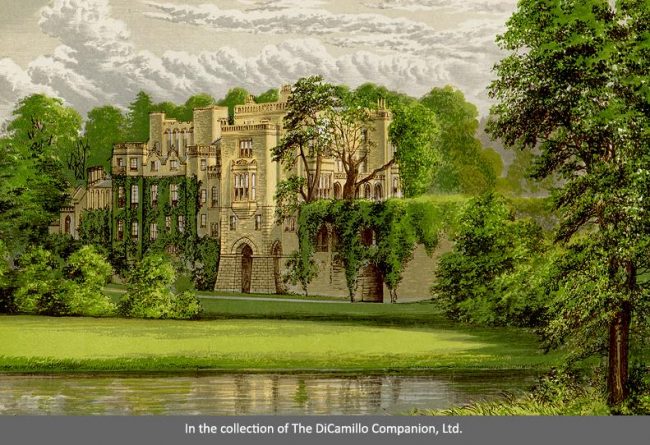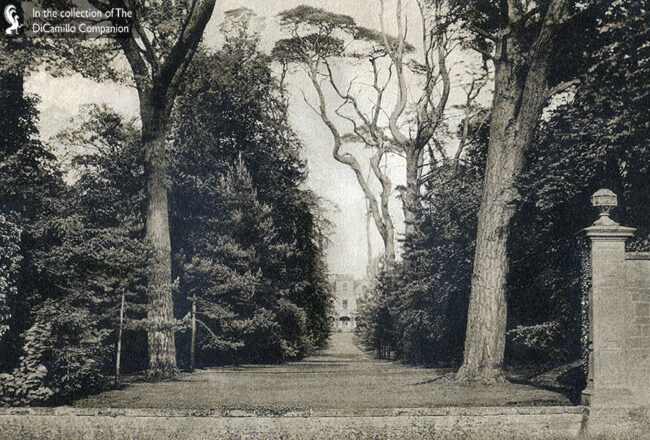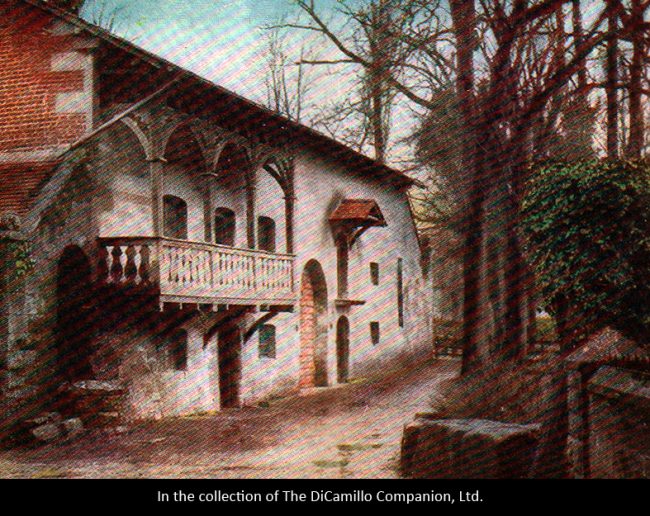
The house from the circa 1880 book "Morris's County Seats"

Looking toward the house from Guy's Cliffe Avenue. From a circa 1902 postcard.

The mill from an early 20th century postcard
Built / Designed For: Samuel Greatheed
House & Family History: Located on the River Avon, there have been buildings at Guys Cliffe since at least Saxon times. Its name supposedly comes from the famous romantic figure Guy of Warwick, believed to have lived in the 10th century, who is said to have retired to a hermitage on the site, leading to the founding of the chantry, parts of which are still extant in today's chapel. Piers Gaveston, the notorious favorite of Edward II, sought refuge and was (allegedly) apprehended at Guys Cliffe before his execution on nearby Blacklow Hill at Leek Wootton. The house at Guys Cliffe, dramatically situated on an outcropping of rock, was begun 1751 in a Palladian style for Samuel (Bertie) Greatheed, a West India merchant, slave trader, and member of Parliament for Coventry between 1747 and 1761. The seven-bay classical Palladian style stone facade was probably built to the designs of William Hiorn and featured a rusticated basement, with dormers over the central section and pediments over the end projections. In the 19th century there were significant alterations to the house, some of it possibly the work of the architect John Gibson. The hall was noted for its fine Rococo plasterwork, now lost, though photos of this beautiful space are in the collection of the NMR (National Monuments Record). Through Samuel Greatheed's daughter, the estate passed to the Percy family (it was Lord Charles Bertie Percy who was responsible for the 19th century alterations and additions to the house). On May 21, 1915, during the Great War, Lord Algernon Malcolm Arthur Percy gave part of Guys Cliffe House over to the British Red Cross to be used as a Voluntary Aid Detachment Hospital. Several rooms, including the dining room, drawing room, and music room, were converted for use as a rest and recuperation center for injured servicemen, a purpose the house served until December 19, 1918 (during this time 663 servicemen were cared for at Guys Cliffe). During World War II Guys Cliffe was vacated by the family and let to the Waifs and Strays Society, who used the house as a boys' home between November 1939 and May 1945. Death duties forced the family to sell the contents in a 1946 auction (a catalog of the contents to be auctioned was commissioned by Captain Josceline Reginald Heber-Percy and Lady Katherine Louisa Victoria Percy, the last family occupants of Guys Cliffe House). In 1947 the family sold the house and decamped to their other seat, Hodnet Hall, in Shropshire. The new owners intended to convert the house into a hotel, but this was never realized, and Guys Cliffe began its long, slow decline. On July 23, 1952 the firm of Robinson, Osbourne & Moules held an auction of the fixtures and fittings of Guys Cliffe (there was also a catalog for this sale); architectural historians have referred to the 1952 auction as "an act of legalized vandalism." It was certainly the final straw in the death spiral of the house. In 1955 Guys Cliffe was purchased by Aldwyn Porter, who leased the chapel to the Freemasons. By 1966 the house's roof had fallen in; by 1974 the fittings and lead from the roof were sold. In 1992 Granada Television purposely set fire to Guys Cliffe while filming an episode of "The Adventures of Sherlock Holmes" entitled "The Last Vampyre;" the fire scene got out of control and seriously damaged the house. In 2004 a proposal to demolish the remains of Guys Cliffe House and to build a small hotel on the site for senior Freemasons was submitted to the local council (the Freemasons still use the chapel for Masonic ceremonies). SAVE Britain's Heritage and other preservation groups have resisted the demolition request, arguing that some parts of the house are eminently salvageable.
Collections: Death duties forced the family to sell the contents in a 1946 auction, for which there was a published catalog. On July 23, 1952 the firm of Robinson, Osbourne & Moules held an auction of the fixtures and fittings of the house (there was also a catalog for this sale).
Garden & Outbuildings: Guy's Cliff Mill, which stands across the river from the house, is on the site of an 11th century mill. The Grade II-listed mill is today The Saxon Mill Restaurant (see photo in "Images" section). In 2012 the Sparkbrook Caribbean and African Women's Development Initiative (SCAWDI) claimed that three carvings in the caves on the Guys Cliffe Estate should be properly interpreted as the heads of black people. Carved in soft chalkstone, SCAWDI believes that the carvings were made in the 18th century by slaves who lived in the caves as the property of Samuel Greatheed, one of the most prominent Caribbean slave traders. It's possible that in 1751 Greatheed brought slaves from his plantations on St. Kitts to build Guys Cliffe House so he wouldn't have to pay wages to British laborers. SCAWDI believes that the carvings are the only such artwork in Europe. The stables were built into the rock face with arcaded ashlar front.
Chapel & Church: Partially hewn into the great outcropping of rock, the 15th century Grade II* chapel, established in 1422 as the Chapel of St. Mary Magdalene, is extant and to the right of the Palladian facade of the house. It was the property of the Catholic Church until the Dissolution of the Monasteries, when the site passed into private ownership. The chapel today has a late 18th century front and features a large statue of Guy of Warwick in the interior. In 1955 it was leased to the Freemasons, who continue to use it today for Masonic ceremonies. The original rock-carved storehouses, built as supporting structures for the chapel, are also extant.
Architect: William Hiorne (Hiorns)
Date: 1751Architect: John Gibson
Date: Circa 1871John Bernard (J.B.) Burke, published under the title of A Visitation of the Seats and Arms of the Noblemen and Gentlemen of Great Britain and Ireland, among other titles: Vol. I, p. 255, 1852.
John Preston (J.P.) Neale, published under the title of Views of the Seats of Noblemen and Gentlemen in England, Wales, Scotland, and Ireland, among other titles: Vol. IV, 1821.
Country Life: I, 154, 1897.
House Listed: Grade II
Park Listed: Grade II
Past Seat / Home of: Samuel (Bertie) Greatheed, 18th century. Lord Charles Bertie Percy, 19th century; Lord Algernon Malcolm Arthur Percy, early 20th century. Aldwyn Porter, mid-20th century.
Current Ownership Type: Other
Primary Current Ownership Use: Ruinous
Ownership Details: Guys Cliffe is owned by a Masonic lodge; they are supported in restoration efforts by the Friends of Guys Cliffe.